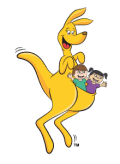Written by Dr Tessa Grigg and Belinda Cummings
There is a story/song about a wise man building his house on the rock which gave strength and stability to the structure. Whereas, as the story goes, the house built on sand came tumbling down. As I write, I am reminded of this story. Foundations are all important in every area of our lives.
The vast array of activities on offer for children these days, whilst wonderful in their variety, may add a level of stress to parenting, and to the child. When trying to decide which of the activities to choose for your child, there are two important questions to consider: Which activities are of most benefit to the child, and what does my child most enjoy? Also, as a parent, you want the child to be able to make the most of their time and your investment. I make no secret of the fact that for babies and children, I am a huge advocate of movement and music. There is now a plethora of research showing that music and movement programs, such as GymbaROO-KindyROO, enhance total development in children; mental, physical, emotional and social.1, 2 However, a well-rounded school-age child has had opportunities to try a range of activities, so that they can discover what they like best.
All complex activities, such as swimming, team sports, dance, tennis, art, learning musical instruments etc., rely on well-established foundation skills. Well-established foundational skills lead to well organised coordination and also to social and emotional maturity, essential for team sports. If these foundational skills are not fully present, or if the child has any retained Primitive Reflexes (as a result of not having had a sufficient amount of the correct movement experiences in the first five years), then complex future activities will be both frustrating and hard work! (For more information on Primitive Reflexes, click here). In Australia many children learn to swim, which is important in a country where bodies of water; beaches, pools, lakes etc., and water sports are common. So, to use swimming as an example, it is very difficult and frustrating for a child to complete most swimming strokes and become proficient at swimming, if the child has retained reflexes. Whenever the child’s head turns, (common in swimming strokes), they cannot prevent their body from being dictated to by the retained reflex, which makes voluntary movement of the arms and legs and smooth coordination of the stroke impossible. The same issue will occur when learning musical instruments; for example, moving the head to place it on the violin chin rest will influence the arms holding the instrument, making it very difficult to maintain the correct holding position.
So, how can parents ensure that the foundational skills are in place and retained reflexes are integrated, so that their children get the most from their chosen activities?
It’s all about the first five years and ensuring the child has the opportunity to pass through the normal, natural sequence of developmental stages and the gross and fine motor movements that accompany each stage. Tummy time and crawling are vital, then walking, running, jumping, hoping, skipping, bike riding, etc. Building skills is progressive and takes time. The child needs plenty of time and movement experiences within each stage to be able to develop all the skills needed to move on to the next stage. It is not a race. It is all about repetition and a range of correct movement opportunities. Lots of time outdoors and at the park is essential – daily if you can manage.
The GymbaROO-KindyROO program is based on developing foundation skills and is a sequenced five-year program (from six weeks old to 5 years old). All through the program, at every age, we are making sure that children have the opportunity to develop the necessary skills for the complex activities they may choose later on. We also focus on providing the correct movement experiences necessary for children to integrate their Primitive Reflexes, essential for success in more complex activities. We have a huge library of fun and wonderful activities specifically appropriate for each stage of a child’s brain growth and development.
It is super beneficial for GymbaROO-KindyROO children to complete the whole five-year program. Children change significantly every six months during their first five years of life. A new part of the child’s brain activates and then consolidates every twelve months, up to the time the child starts going to formal school. The child’s brain needs the correct movement stimulation and experiences, and lots of it, during the entire five years to help maximise learning capacity. Completing limited parts of the GymbaROO-KindyROO program may impact the child ability to reach their full potential. To return to the ‘building a house’ analogy, if gaps are allowed in any part of the house during the early construction phases, then there can be significant problems in the next levels and the final structure of the building will be compromised. The house built on a rock will definitely fare much better.
So, while GymbaROO-KindyROO is focused on fun, there is some very serious learning and development going on, that is establishing an important foundation for all future activities.
References:
- Collins A. The Music Advantage: How learning music helps your child’s brain and wellbeing: Allen & Unwin; 2020.
- Misuraca R, Miceli S, Teuscher U. Three effective ways to nurture our brain: Physical activity, healthy nutrition, and music: A review. European Psychologist. 2017;22(2):101–20.
Authors:
Dr Tessa Grigg (PhD, Dip Tch Primary and ECE) is an experienced teacher and the Research and Education Manager at GymbaROO-KindyROO.
Bindy Cummings (B.Ed hons) is a teacher, a GymbaROO early childhood neuro-developmental consultant and the co-creator of GymbaROO’s Active Babies Smart Kids series. She has been writing articles for GymbaROO’s First Steps magazine, digital platforms and media for over fifteen years.

